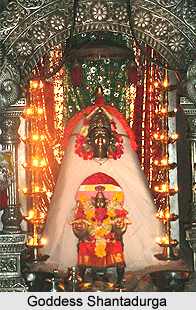 Shantadurga Kalangutkarin Temple, dedicated to goddess Shantadurga, is located in the Nanoda village in Bicholim taluka in Goa. The goddess, usually worshipped in a Shanta form, is revered by the devotees as Vishweshwari in this pilgrimage centre.
Shantadurga Kalangutkarin Temple, dedicated to goddess Shantadurga, is located in the Nanoda village in Bicholim taluka in Goa. The goddess, usually worshipped in a Shanta form, is revered by the devotees as Vishweshwari in this pilgrimage centre.
History of Shantadurga Kalangutkarin Temple
Originally, Shantadurga Kalangutkarin Temple was constructed in Calangute near Mapusa City Taluka Badez. During the 17th century the temple was moved from its original location to Nanora, located between the city of Assonora and Mulgaon, in Bicholim Taluka due to the torments inflicted by the Portuguese invaders on the Hindus and the forceful conversion into their religion.
Architecture of Shantadurga Kalangutkarin Temple
Shantadurga Kalangutkarin Temple is originally a 17th century edifice that has undergone repair and renovation work in the 1990s. During the restoration work the temple was constructed into a marble masterwork, reflecting the contemporary aesthetic and ingenious sagacity of the artisans.
The ancient temple is dedicated to goddess Shantadurga, seen meditating between Lord Vishnu and Lord Shiva. The deity, believed to a bestower of wealth; wisdom; fertility; generosity; fortune and courage, is also known as `Santeri.` According to a mythological fable, once a terrifying battle took place between Shiva and Vishnu. Goddess Parvati, as requested by Lord Brahma intervened in the form of Shantadurga. She resolved the battle placing Shiva on her left hand and Vishnu on her right hand.
Shantadurga is seen carrying two serpents in each of her hand that represents Shiva and Vishnu. The goddess also referred to as a symbol of beauty, prosperity and success is said to have visited Kalangut, a village in Bardez Taluka, to serve the residents and bless them with education, prosperity and good health. For her services she was named as Rudaya Mohini. Besides, the temple also houses a Shivalingam in its sanctum sanctorum, deemed to be more than 800 years old. Shantadurga Kalangutkarin Temple is adorned with a Dipa Stambha and has agrashalas i.e. guest houses for the pilgrims.
Festivals of Shantadurga Kalangutkarin Temple
Shantadurga Kalangutkarin Temple celebrates several festivals such as Navaratri, Akshay Tritiya, Vasant Panchami and Shravani Somvar. Shishirotsav also known as Shigmo is the most important festival celebrated for almost 10 days. The festival is a colourful representation of the cultural life of the Goans. Grand processions of different deities on their respective vehicles and performance of sacred rituals such as homa, Gulalotsava, kalotsav, Dhwajarohana, Rathotsava is the significant feature of Shigmo festival.
Shantadurga regarded as the patron deity of Kalavants, Kulee Maratha and Rajapur Saraswat Brahmins is worshipped with great devotion by the devotees visiting the temple from far off places.











